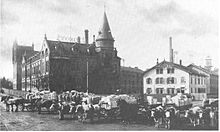Rathenauplatz (Heilbronn)
The Rathenauplatz is located at the southern end of Wilhelmstrasse in Heilbronn . The square, named after Foreign Minister Walther Rathenau , who was murdered in 1922, is one of the few squares in Heilbronn with a relatively large amount of preserved historical buildings. The Heilbronn red light district was located there from the 1970s to the 1990s .
history
The Rathenauplatz and the Knorrstrasse are located on a former Bronze Age and Celtic burial ground . Graves were found that belong to the older urn field culture or to the more recent, early Latène period .
The site was not built over as planned until 1873, when a new residential area was built in the south of Heilbronn and the south station was built. With its own railway siding opened Knorr there its production of soup preparations.
The square, located just south of the old town, survived the air raids on Heilbronn during the Second World War , in which the entire old town was destroyed, with comparatively little damage.
In the post-war period, Rathenauplatz was also known as the “Anhalter Bahnhof” because a passenger center was built there between the Südbahnhof and Knorr. The wooden fence near Knorr also served as a "notice board" for search advertisements and offers of all kinds. In the middle of the Rathenauplatz there was a lawn roundel with an electric clock, which was repaired by October 14, 1948.
In the early 1970s, the Heilbronn red light district established itself on Rathenauplatz. The actual brothels ("S 3" and "S 7") were in the buildings Sontheimer Strasse 3 and 7 , which are located directly at the confluence of Sontheimer Strasse in Rathenauplatz. There was also the Regina Bar at Sontheimer Straße 19, a nightclub with striptease shows. In different buildings on Rathenauplatz there were bars and restaurants such as the Metro Bar , the Eden Bar or the Europäische Hof , some of which were run by the same owners and frequented by customers of the red light district. The clientele included above all soldiers from the American barracks located just south of Rathenauplatz. Further restaurants for the primarily American public were lined up behind the Europäische Hof on Wilhelmstrasse , e.g. B. the Liberty Pub at Wilhelmstrasse 66 . One of the well-frequented entertainment venues for the Americans was the Altstadt disco in the spacious basement of Happelstrasse 29 a few meters east of Rathenauplatz.
The city of Heilbronn bought some of the earlier red-light buildings in the late 1990s and relocated the red-light district to Heilbronner Hafenstrasse. The former red light mile was then considered the redevelopment area Rathenauplatz Quadrant IV, Heilbronn . Of the former red light operations around Rathenauplatz, only the Regina Bar remains.
present
The “partly listed, partly also classified as important from an urban planning point of view” on Rathenauplatz were renovated at the beginning of the 21st century. Historic buildings on Rathenauplatz are the listed European courtyard on the corner of Wilhelmstrasse / Rathenauplatz and the listed building of the former Metro Bar on the corner of Charlotten - / Sontheimer Strasse / Rathenauplatz. Today the buildings are mostly used for residential or office purposes.
Other prominent buildings on Rathenauplatz are the Knorr building on the corner of Sontheimer Straße / Rathenauplatz and the Knorr Cooking Center.
Individual evidence
- ^ Julius Fekete , Simon Haag, Adelheid Hanke, Daniela Naumann: Stadtkreis Heilbronn . (= Monument topography Federal Republic of Germany , cultural monuments in Baden-Württemberg, Volume I.5.). Theiss, Stuttgart 2007, ISBN 978-3-8062-1988-3 , pp. 111 .
- ^ Julius Fekete , Simon Haag, Adelheid Hanke, Daniela Naumann: Stadtkreis Heilbronn . (= Monument topography Federal Republic of Germany , cultural monuments in Baden-Württemberg, Volume I.5.). Theiss, Stuttgart 2007, ISBN 978-3-8062-1988-3 , pp. 51 .
- ^ Julius Fekete , Simon Haag, Adelheid Hanke, Daniela Naumann: Stadtkreis Heilbronn . (= Monument topography Federal Republic of Germany , cultural monuments in Baden-Württemberg, Volume I.5.). Theiss, Stuttgart 2007, ISBN 978-3-8062-1988-3 , pp. 47 .
- ↑ Just to 17h . In: Uwe Jacobi: Heilbronn - The most beautiful years? Post-war period in a German city . Heilbronner Stimm Druckerei und Verlagsanstalt GmbH, Heilbronn 1984, ISBN 3-921923-01-8 ( series on Heilbronn. Volume 9), p. 72
- ↑ Alexander Renz: Chronicle of the city of Heilbronn . Volume VI: 1945-1951. Heilbronn City Archives, Heilbronn 1995, ISBN 3-928990-55-1 , p. 271 ( Publications of the Archives of the City of Heilbronn Volume 34).
- ↑ The line. 13th improved edition, Berlin 1984/85, pp. 258/259.
- ^ Maria Theresia Heitlinger: Rescue for Rathenauplatz in sight . In: Heilbronn voice . January 17, 2007 ( from Stimme.de [accessed November 7, 2009]).
- ↑ Joachim Friedl: Rats and Garbage . In: Heilbronn voice . February 4, 2008 ( from Stimme.de [accessed November 7, 2009]).
- ↑ Why the nightlife blooms on a bright day . In: Heilbronn voice . May 18, 2002.
- ^ A b Joachim Friedl: Nursing home in ex-cathedrals . In: Heilbronn voice . June 19, 2004 ( from Stimme.de [accessed November 7, 2009]).
literature
- Uwe Jacobi : The 50s in Heilbronn and the region. 3 volumes. Wartberg-Verlag, Gudensberg-Gleichen 2002–2004, ISBN 3-8313-1034-3 , ISBN 3-8313-1035-1 , ISBN 3-8313-1252-4
Coordinates: 49 ° 7 '54.7 " N , 9 ° 13' 5.3" E







